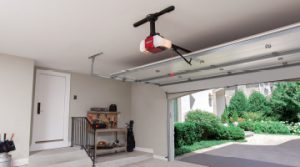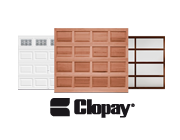
Garage door openers are so convenient that it’s easy to take them for granted. You just press the button on your door opener remote, and your door opens for you every time. In fact, more and more people are using their garage door as the main door in and out of their home. Even the kids just use the exterior keypad to get inside when they get home from school.
It’s all too easy, though, to forget that your garage door is the biggest moving part on your entire home, and that it needs occasional maintenance to be safe. When was the last time you did an inspection or any maintenance on yours?
Follow these four simple steps to ensure that your garage door and opener are safe for you and your family to use. Do this twice a year – in the spring and fall – and you’ll be set with a safe and reliable garage door.
Step 1: Visually Inspect the Door
- Standing at the back of the garage, look at the horizontal tracks. They should be parallel with no tilt toward or away from each other. The bolts should also be holding the horizontal tracks securely together and in place.y
- Walking toward the door, inspect the hinges. Are all screws secured? Check out the rollers. Are they in good condition? Do they roll easily along the tracks without sliding?
Step 2: Disconnect the door opener
- Next, disconnect the door opener from the door by pulling on the emergency release cord. This is usually a red cord and should be easy to spot.
- Manually raise the door with the lift handle at the second section or bottom of the door. If the handle is at the bottom of the door, be sure to lift with your legs, not your back.
- Was lifting the door hard? A well‑balanced, counterweighted door should have a deadweight of 8‑10 pounds (3.5‑4.5 kilograms). If it does, this shows that the spring system is working well and that the door is in good condition.
- If it seems heavy, especially if it takes more than one hand to lift, you probably have an issue with the springs, which most likely need to be replaced.
- Remember, your door opener is just replacing your effort. Some openers are specifically calibrated to pull up to 250 pounds (110 kg), but that’s not all they can do. They can also push that weight down, as well, which could put you and your family in danger if your opener isn’t calibrated and installed correctly.
- If you have a problem like this, don’t try to fix it yourself. Stop using the garage door and opener immediately and call us.
Step 3: Do a reversal test
- Reconnect the opener to the door. Make sure that you hear a positive click and that it’s safely in place.
- Use your opener’s remote to open the door.
- All garage door openers manufactured before 1986 have a single mechanical reversal system, while all openers manufactured after this date have a mechanical reversal system and a photoelectric reversal system. You’ll want to test both systems.
- Testing the mechanical system:
- Put a piece of wood in the path of the door on its threshold.
- Hit the remote button to close the door.
- When the door touches the piece of wood, it should stop and open up again.
- If it doesn’t reverse, you’ll need to adjust the button on the motor housing that controls the door’s descent. You can identify it by its down‑pointing arrow.
- Testing the photoelectric system:
- Look for two small units, one on each side of the opening of the door, about four to five inches (10 to 15 centimeters) from the floor.
- Press the remote button while standing near the garage door.
- As the door starts to lower, pass one foot between the two units (where there’s an invisible light beam).
- The door should stop for less than a second and then reverse back up.
- If your door opener isn’t working at all, it could be because the units are misaligned or the wire to one of them has been severed.
Step 4: Lubrication
- For a chain‑driven garage door opener:
- Apply a small amount of petroleum‑based oil to the chain.
- With a rag, wipe away any excess.
- Apply oil or white grease to the motor’s gear and sprocket assembly.
- Look at the other end of the trolley for another sprocket and repeat the same process.
- For a belt‑driven opener (with a metal‑reinforced rubber belt):
- Do not lubricate the belt.
- The technician who installed your opener applied enough grease to keep the belt working for years.
Safety warning: Garage door openers aren’t toys!
- Do not let children use your opener’s remote control without supervision.
- Apply the same rule to the control panel, next to the access door to the house. When installed, it should be placed at least five feet (1.5 meters) from the floor.
- Never run to get out of the garage after using this panel or the remote to close the garage door. Most accidents and injuries involving garage doors happen this way.
- Inform children to stay away from the door when it’s opening or closing.
- Make sure your kids know that they should never tell the four‑digit access code for the door to their friends or anyone else.
Always remember – better safe than sorry! For more information on basic garage door opener safety rules and practices, watch this video. And don’t hesitate to visit www.garagedoorcare.com, a helpful garage door industry website.
Whatever you need for your garage door, garage door opener, components, and/or accessories, go ahead and click here to get a free quote, or click here to start building the perfect garage door for you! Or call us today at:
- London: 519-685-9797
- Mount Pleasant: 905-304-9700
- Guelph: 519-821-4400
- Goderich: 519-482-3251










Add new comment